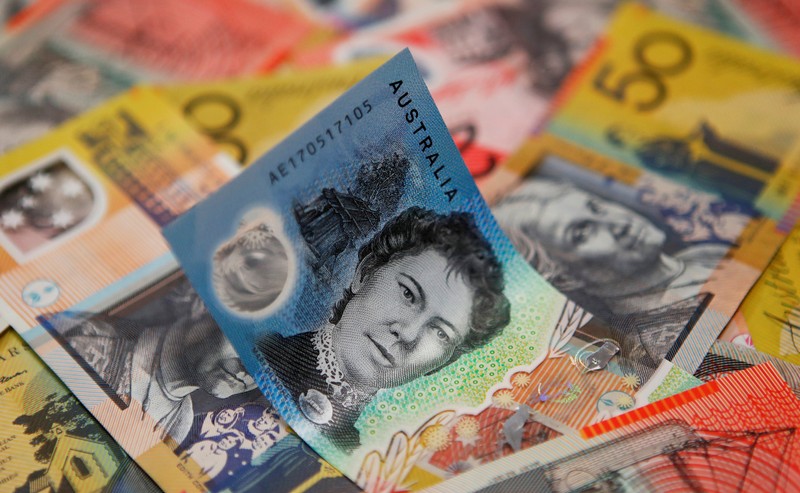
FILE PHOTO: Australian dollars are seen in an illustration photo February 8, 2018. REUTERS/Daniel Munoz/File Photo
May 7, 2019
By Tommy Wilkes
LONDON (Reuters) – The Australian dollar surged on Tuesday after the country’s central bank held interest rates at a record low, while currency markets stabilized following U.S. President Donald Trump’s threat of additional tariffs on Chinese goods.
Foreign exchange markets were mostly quiet, with investors far from panicking about the prospect of a breakdown in negotiations between China and the United States to resolve their trade dispute.
The Aussie rallied as much as 0.8 percent to $0.7048, after the Reserve Bank of Australia held rates, dashing speculation it may ease policy following a weaker-than-expected reading of inflation.
Central banks across the globe have turned increasingly dovish in 2019, raising expectations that policymakers would ease monetary conditions.
“Today’s position from the RBA marks a correction to the recent trend in G10 FX, where expectations of policy normalization have been scaled back and fresh easing (particularly in Australia and New Zealand) has been priced in,” ING analysts said.
Australia’s central bank, however, opened the door wider for future cuts should the jobs market not improve.
RELAXED
Trump tweeted on Sunday that he would raise tariffs on $200 billion worth of Chinese goods to 25 percent from 10 percent by the end of the week and would “soon” target the remaining Chinese imports with tariffs.
But U.S. Trade Representative Robert Lighthizer said he expected the top Chinese negotiator Vice Premier Liu to lead a delegation from Beijing for talks in Washington this week, and some investors interpreted Trump’s threat as a negotiating tactic.
“As long as the talks continue, the market will remain relaxed…that there will be a deal after all,” said Esther Reichelt, a currency analyst at Commerzbank, while adding that this week’s developments forced the market to reprice its expectations.
“The market was very optimistic, maybe a bit too optimistic,” she said.
The offshore yuan on Monday was on course for its worst daily drop in 10-months, briefly touching a four-month low of 6.8218 after Trump’s tariff threat, but it later erased most of those losses.
Graphic: Chinese offshore yuan vs U.S. dollar – https://tmsnrt.rs/2WtQgQw
China’s offshore exchange rate stood unchanged at 6.7741 yuan per dollar by 0845 GMT.
The U.S. dollar was flat, with the index at 97.528.
The safe-haven yen added 0.1 percent to 110.665 yen after briefly touching a five-week high on Monday.
The euro slipped marginally to $1.1195.
The Swedish crown rallied after central bank board members said that while inflation was weak it did not justify an overhaul of policy, according to minutes from the recent Riksbank meeting. The crown rose 0.3 percent to 10.6875 crowns per euro.
Sterling reversed earlier gains to trade down 0.1 percent at $1.3124 after hopes that talks between the Conservative and Labour parties over Brexit can make headway had last week sent the pound to one-month highs.
(Editing by Kirsten Donovan/Emelia Sithole-Matarise)

